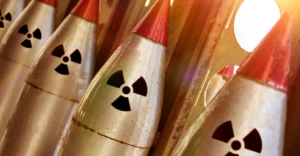
Hostilities in Ukraine do not stop due to weather challenges, but they have slowed down. Serhiy Zgurets' column.
Both Ukraine and Russia are using much less equipment than in the summer or dry period. Enemy losses confirm this: 610 troops, zero tanks, 6 infantry fighting vehicles and 4 artillery systems were destroyed over the past day. That is, much less than usual
Frontline situation
I'll start with the weather, because the increasingly bad autumn weather in Ukraine has not stopped the fighting, but it is slowing down the advance of the Ukrainian military and the enemy on the battlefield. At the moment, it is difficult to move along the roads after rain or after the snow has melted. This affects the pace of combat operations. That's why we are using much less equipment now than in the summer or dry period. By the way, this is confirmed by the enemy's losses.
On one of the previous days, 610 invaders, zero tanks, 6 armored personnel carriers and 4 artillery systems were destroyed. That is, much less than usual. However, it is significant that the number of combat engagements on the frontline has not decreased. There were 70 of them, and about 40 of them were in the areas of Bakhmut, Avdiivka and Marinka. Today, Army Commander Oleksandr Syrskyi said that the enemy is trying to attack in the area of Klishchiivka, pulling up reserves, and somehow trying to overturn the results of the fighting that have been achieved so far.
Bakhmut direction
Oleh Kalashnikov, a spokesman for the 26th Artillery Brigade named after Major General Roman Dashkevych, said the situation was indeed very difficult. While there was more or less a ceasefire on the northern flank of the Bakhmut sector, in recent weeks we have seen the enemy intensify its actions in this area. That is, the enemy is attacking in the direction of the settlements of Bohdanivka and Khromove, trying to dislodge the defence forces..
The invaders are attempting to stabilize the front line and make it more convenient for them. We also observe enemy counterattacks on the southern flank. If we take Klishchiivka, the Russians are attacking Ukrainian positions from several directions, attacking directly from Bakhmut, from the direction of Zaitseve and Odradivka. The Russian forces are also attacking Andriivka from two directions.

The spokesman for the 26th Artillery Brigade noted the Russians once tried to create a small defensive line on the railroad line, but they failed. Now the enemy is trying to regain what they have lost. They are trying to counterattack in the area of Klishchiivka, because there are dominant heights there that allow Ukrainian defenders to counterattack the railroad, because it is located in a lowland. To do this, the enemy has deployed both manpower and artillery, which it has in abundance in this area. The invaders are also using the aviation component with aircraft.
Kalashnikov said the enemy had recently resumed its bloody 'human wave' attacks, which waste personnel. The enemy is not saving people, it is launching counter-attacks on Ukrainian positions without much support from armoured combat vehicles, only artillery. Professional Russian forces are present in the Bakhmut direction. There are airborne units, air assault units, which are the enemy's elite units. In this area, we could see all three airborne assault units that the Russian Airborne Forces have in general. They act differently, more sparingly and professionally, saving the lives of their personnel because these units are more trained. Here we see different tactical hostile actions on the battlefield.
The serviceman added that he would not be revealing any secrets if he said that the Ukrainian Defense Forces have been using ammunition sparingly over the past two years. This was the case at the beginning of the full-scale clash, when Ukrainian forces tried to work on targets rather than on the ground, and it is the same today. In addition, now that we have NATO artillery equipment in service, it is more accurate and it really helps us not to waste a large number of rounds on a target. In other words, the Ukrainian Armed Forces are working efficiently, as they always have. And this does not prevent them from destroying the enemy, its ammunition depots, heavy equipment, artillery and electronic warfare. There is enough ammunition to do the job. Of course, if there were more shells, the Ukrainian defenders would only thank their partners for their help in liberating our territory faster.
Electronic warfare means
Oleh Kalashnikov has repeatedly spoken about electronic warfare equipment, which is important for us to counter enemy FPV drones and other enemy unmanned systems. We will talk about this topic in more detail with our next guest, Serhiy Beskrestnov, a military specialist in electronic warfare.
Russian FPV drones, Lancets, and guided bombs are our three main high-tech problems that the enemy is using quite successfully. An FPV drone is a disposable drone that carries a charge and is controlled from the ground or from the air via a transponder. This drone transmits a video signal. We can detect these drones by the image, and fight them by suppressing the control signals.
Unfortunately, the control signal transmissions are very stable and difficult to suppress. That's why we and the Russians are in the same position here. Both they and we are trying to create complexes, so-called domes, to protect against FPV drones. At the moment, I estimate the effectiveness of such systems at 35-40%. It all depends on the skill of the pilot and the equipment at any given time. The Russians have Volnoriez and Tryton systems to protect their equipment from our FPV drones, and their effectiveness is the same as ours.
Serhiy Beskrestnov noted the problem with electronic warfare and FPV is that as soon as we and the Russians develop effective means of small, trench-based electronic warfare against FPV, working groups immediately develop new technologies, namely, switching to other frequencies. We shouldn't underestimate the enemy, as they also have specialists working with the same equipment. That is, this war is absolutely mirrored, an endless struggle between electronic warfare, communications, and technology.
Beskrestnov added that new FPV drones can be made quickly, but it takes much longer to train a new crew. That's why there is a hunt for such crews, so we need to take this into account and disguise ourselves more. The main vulnerability is that when an FPV drone is flying, it has an open, unprotected video channel that can be used to track and reverse the point of departure of the drone. So both we and the Russians are vulnerable. There are certain tips and tricks to counter this, but such recommendations are provided through closed channels so that the enemy does not use them. At this time, we can make a general recommendation - when an FPV drone flies at full power and transmits a signal on the 5.8 or 11.3 band, it carries information that can be intercepted and used for counterattack.
To summarize, I would like to draw attention to the fact that Serhiy Beskrestnov has made an excellent instruction that describes what to do in certain cases, how to properly use trench electronic warfare equipment, and what threats exist. I hope that everyone has received these recommendations in a private mode and will use them on the battlefield with a sufficiently high level of efficiency.
- News














































